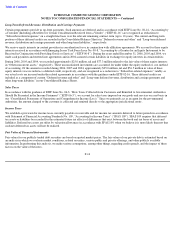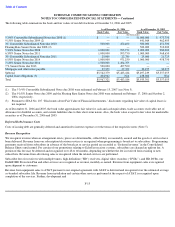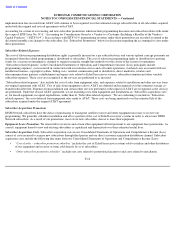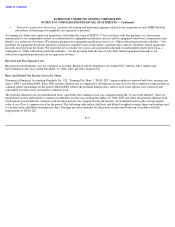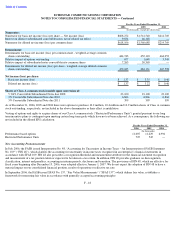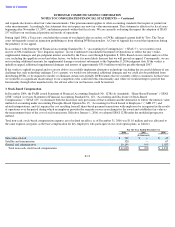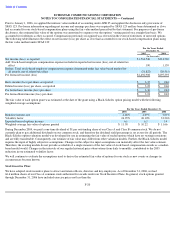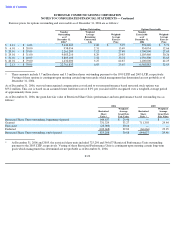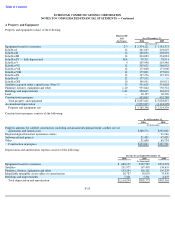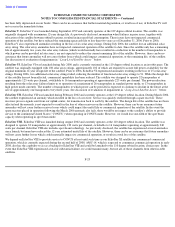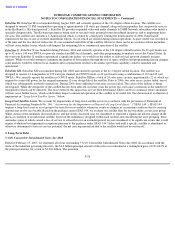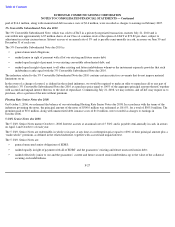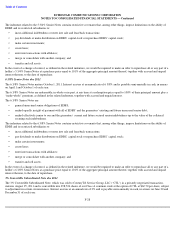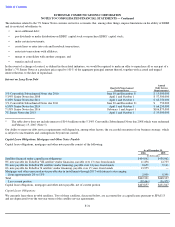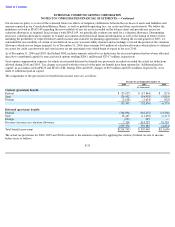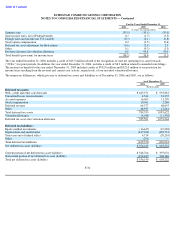Dish Network 2007 Annual Report Download - page 111
Download and view the complete annual report
Please find page 111 of the 2007 Dish Network annual report below. You can navigate through the pages in the report by either clicking on the pages listed below, or by using the keyword search tool below to find specific information within the annual report.
Table of Contents
ECHOSTAR COMMUNICATIONS CORPORATION
NOTES TO CONSOLIDATED FINANCIAL STATEMENTS — Continued
Cost of sales and operating expense categories included in our accompanying Consolidated Statements of Operations and Comprehensive
Income (Loss) do not include depreciation expense related to satellites or equipment leased to customers.
Our Satellites
We presently transmit programming from 14 satellites in geostationary orbit approximately 22,300 miles above the equator. Of these 11 are
owned and three are leased. Each of the owned satellites had an original minimum useful life of at least 12 years. Two of the leased satellites
are accounted for as capital leases pursuant to Statement of Financial Accounting Standard No. 13, “Accounting for Leases” (“SFAS 13”) and
are depreciated over the ten-year terms of the satellite service agreements. Our satellite fleet is a major component of our EchoStar DBS
System. While we believe that overall our satellite fleet is generally in good condition, during 2006 and prior periods, certain satellites in our
fleet have experienced anomalies, some of which have had a significant adverse impact on their commercial operation. We currently do not
carry insurance for any of our owned in-orbit satellites. We believe we generally have in-orbit satellite capacity sufficient to recover, in a
relatively short time frame, transmission of most of our critical programming in the event one of our in-orbit satellites were to fail. We could
not, however, recover certain local markets, international and other niche programming in the event of such failure, with the extent of
disruption dependent on the specific satellite experiencing the failure. Further, programming continuity cannot be assured in the event of
multiple satellite losses.
EchoStar I.
EchoStar I was launched during December 1995 and currently operates at the 148 degree orbital location. The satellite can operate
up to 16 transponders at 130 watts per channel. During the second quarter of 2006, the satellite experienced anomalies resulting in the possible
loss of two solar array strings. An investigation of the anomalies is continuing. The anomalies have not impacted commercial operation of the
satellite to date. Even if permanent loss of the two solar array strings is confirmed, the original minimum 12-year design life of the satellite is
not expected to be impacted since the satellite is equipped with a total of 104 solar array strings, only approximately 98 of which are required to
assure full power availability for the design life of the satellite. However, there can be no assurance future anomalies will not cause further
losses which could impact the remaining life or commercial operation of the satellite.
EchoStar II.
EchoStar II was launched during September 1996 and currently operates at the 148 degree orbital location. The satellite can
operate up to 16 transponders at 130 watts per channel. During February 2007, the satellite experienced an anomaly which prevented its north
solar array from rotating. Functionality was restored through a backup system. The design life of the satellite has not been affected and the
anomaly is not expected to result in the loss of power to the satellite. However, if the backup system fails, a partial loss of power would result
which could impact the useful life or commercial operation of the satellite.
EchoStar III.
EchoStar III was launched during October 1997 and currently operates at the 61.5 degree orbital location. The satellite was
originally designed to operate a maximum of 32 transponders at approximately 120 watts per channel, switchable to 16 transponders operating
at over 230 watts per channel, and was equipped with a total of 44 transponders to provide redundancy. Prior to 2006, traveling wave tube
amplifiers (“TWTA”)
anomalies caused 22 transponders to fail. During April and October 2006, further TWTA anomalies caused the failure of
four additional transponders. As a result, a maximum of 18 transponders are currently available for use on EchoStar III, but due to redundancy
switching limitations and specific channel authorizations, we can only operate 15 of the 19 FCC authorized frequencies we have the right to
utilize at the 61.5 degree location. While we do not expect a large number of additional TWTAs to fail in any year, and the failures have not
reduced the original minimum 12-year design life of the satellite, it is likely that additional TWTA failures will occur from time to time in the
future, and those failures will further impact commercial operation of the satellite.
EchoStar IV.
EchoStar IV was launched during May 1998 and currently operates at the 77 degree orbital location, which is licensed by the
government of Mexico to a venture in which we hold a minority interest. The satellite was originally designed to operate a maximum of 32
transponders at approximately 120 watts per channel, switchable to 16 transponders operating at over 230 watts per channel. As a result of past
TWTA failures, only six transponders are currently available for use and the satellite
F-24


